Quickstart: Connect and query a SQL Server instance using SQL Server Management Studio (SSMS)
Applies to:
SQL Server
Get started using SQL Server Management Studio (SSMS) to connect to your SQL Server instance and run some Transact-SQL (T-SQL) commands.
Note
While Microsoft Entra ID is the new name for Azure Active Directory (Azure AD), to prevent disrupting existing environments, Azure AD still remains in some hardcoded elements such as UI fields, connection providers, error codes, and cmdlets. In this article, the two names are interchangeable.
The article demonstrates how to follow the below steps:
- Connect to a SQL Server instance
- Create a database
- Create a table in your new database
- Insert rows into your new table
- Query the new table and view the results
- Use the query window table to verify your connection properties
This article covers connecting and querying an instance of SQL Server. For Azure SQL, see Connect and query Azure SQL Database & SQL Managed Instance.
To use Azure Data Studio, see connect and query SQL Server, Azure SQL Database, and Azure Synapse Analytics.
To learn more about SQL Server Management Studio, see Tips and tricks for using SQL Server Management Studio (SSMS).
Prerequisites
To complete this quickstart, you need the following prerequisites:
- Install Download SQL Server Management Studio (SSMS).
- Install SQL Server from the Installation Wizard (Setup) and configure a SQL Server instance.
Connect to a SQL Server instance
To connect to your SQL Server instance, follow these steps:
Start SQL Server Management Studio. The first time you run SSMS, the Connect to Server window opens. If it doesn't open, you can open it manually by selecting Object Explorer > Connect > Database Engine.

The Connect to Server dialog box appears. Enter the following information:
Setting Suggested values Description Server type Database Engine For Server type, select Database Engine (usually the default option). Server name The fully qualified server name For Server name, enter the name of your SQL Server (you can also use localhost as the server name if you're connecting locally). If you're NOT using the default instance - MSSQLSERVER - you must enter in the server name and the instance name.
If you're unsure how to determine your SQL Server instance name, see Additional tips and tricks for using SSMS.Authentication Windows Authentication
SQL Server Authentication
Microsoft Entra authenticationWindows Authentication is set as default.
You can also use SQL Server Authentication to connect. However, if you select SQL Server Authentication, a username and password are required.
Microsoft Entra authentication is available for SQL Server 2022 (16.x) and later versions. For step-by-step configuration instructions, see Tutorial: Set up Microsoft Entra authentication for SQL Server
For more information about authentication types, see Connect to the server (database engine).Login Server account user ID The user ID from the server account used to sign in to the server. A login is required when using SQL Server Authentication. Password Server account password The password from the server account used to sign in to the server. A password is required when using SQL Server Authentication. Encryption 1 Encryption method Select the encryption level for the connection. The default value is Mandatory. Trust server certificate Trust Server Certificate Check this option to bypass server certificate validation. The default value is False (unchecked), which promotes better security using trusted certificates. Host Name in Certificate Host name of the server The value provided in this option is used to specify a different, but expected, CN or SAN in the server certificate. 1 The default value is Mandatory in SSMS 20. Strict (SQL Server 2022 and Azure SQL) encryption should be used for Azure SQL Database and Azure SQL Managed Instance. Strict (SQL Server 2022 and Azure SQL) encryption can be used for SQL Server when the instance has Force Strict Encryption enabled.

After you complete all the fields, select Connect.
You can also modify extra connection options by selecting Options. Examples of connection options are the database you're connecting to, the connection timeout value, and the network protocol. This article uses the default values for all the fields.
To verify that your SQL Server connection succeeded, expand and explore the objects within Object Explorer where the server name, the SQL Server version, and the username are displayed. These objects are different depending on the server type.
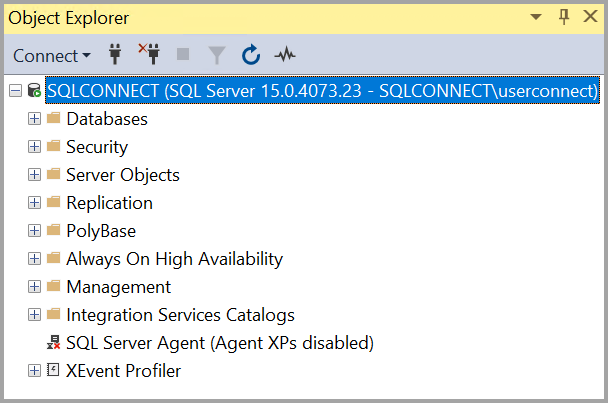
Create a database
Now let's create a database named TutorialDB by following the below steps:
Right-click your server instance in Object Explorer, and then select New Query:
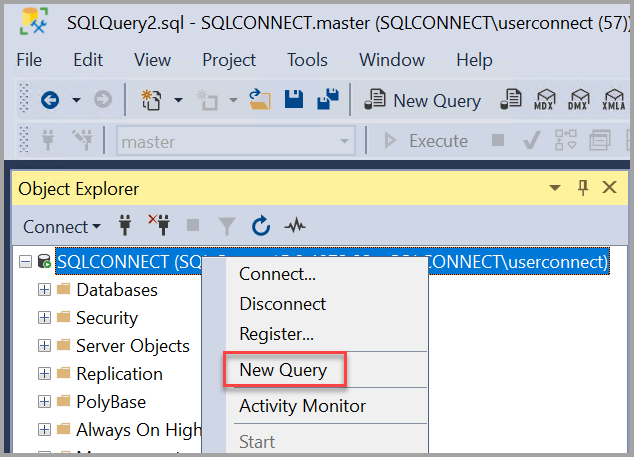
Paste the following T-SQL code snippet into the query window:
USE master GO IF NOT EXISTS ( SELECT name FROM sys.databases WHERE name = N'TutorialDB' ) CREATE DATABASE [TutorialDB] GOExecute the query by selecting Execute or selecting F5 on your keyboard.
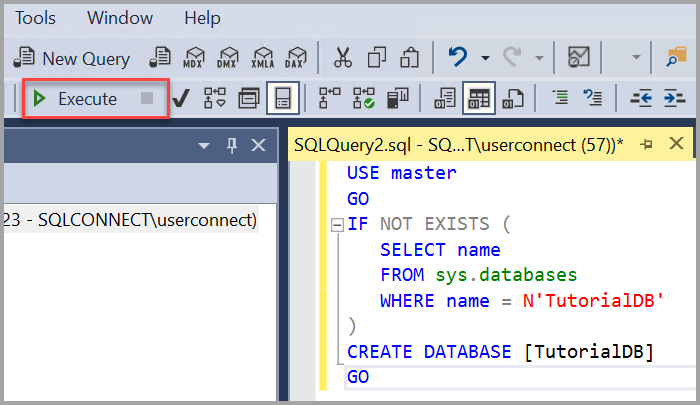
After the query is complete, the new TutorialDB database appears in the list of databases in Object Explorer. If it isn't displayed, right-click the Databases node, and then select Refresh.
Create a table
In this section, you create a table in the newly created TutorialDB database. Because the query editor is still in the context of the master database, switch the connection context to the TutorialDB database by doing the following steps:
In the database dropdown list, select the database that you want, as shown here:
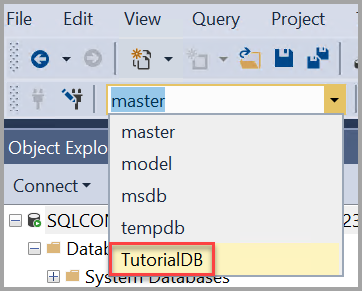
Paste the following T-SQL code snippet into the query window:
USE [TutorialDB] -- Create a new table called 'Customers' in schema 'dbo' -- Drop the table if it already exists IF OBJECT_ID('dbo.Customers', 'U') IS NOT NULL DROP TABLE dbo.Customers GO -- Create the table in the specified schema CREATE TABLE dbo.Customers ( CustomerId INT NOT NULL PRIMARY KEY, -- primary key column Name NVARCHAR(50) NOT NULL, Location NVARCHAR(50) NOT NULL, Email NVARCHAR(50) NOT NULL ); GOExecute the query by selecting Execute or selecting F5 on your keyboard.
After the query is complete, the new Customers table is displayed in the list of tables in Object Explorer. If the table isn't displayed, right-click the TutorialDB > Tables node in Object Explorer, and then select Refresh.

Insert rows
Now let's insert some rows into the Customers table that you created. Paste the following T-SQL code snippet into the query window, and then select Execute:
-- Insert rows into table 'Customers'
INSERT INTO dbo.Customers
([CustomerId],[Name],[Location],[Email])
VALUES
( 1, N'Orlando', N'Australia', N''),
( 2, N'Keith', N'India', N'keith0@adventure-works.com'),
( 3, N'Donna', N'Germany', N'donna0@adventure-works.com'),
( 4, N'Janet', N'United States', N'janet1@adventure-works.com')
GO
Query the table and view the results
The results of a query are visible below the query text window. To query the Customers table and view the rows that were inserted, paste the following T-SQL code snippet into the query window, and then select Execute:
-- Select rows from table 'Customers'
SELECT * FROM dbo.Customers;
The query results are displayed under the area where the text was entered.
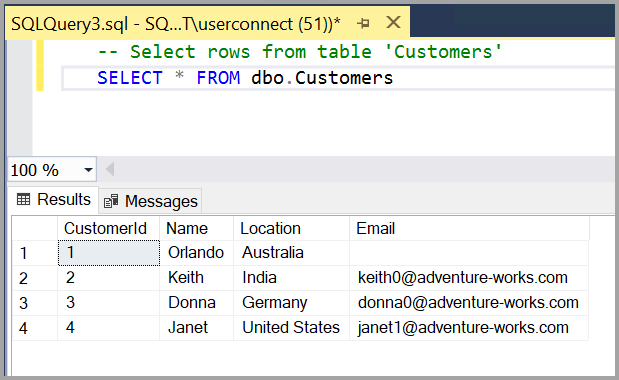
You can also modify the way results are presented by selecting one of the following options:
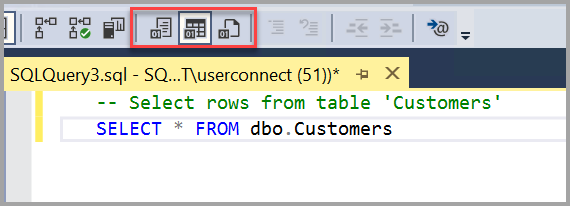
- The first button displays the results in Text View, as shown in the image in the next section.
- The middle button displays the results in Grid View, which is the default option.
- The third button lets you save the results to a file whose extension is .rpt by default.
Troubleshoot connectivity issues
To review troubleshooting techniques to use when you can't connect to an instance of your SQL Server Database Engine on a single server, visit Troubleshoot connecting to the SQL Server Database Engine.